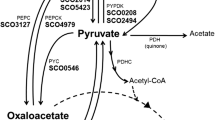Abstract
The ATP pool of Streptococcus cremoris in a lactose-limited chemostat depletes rapidly when lactose is consumed. The decrease of the intracellular ATP concentration parallels the dissipation of the electrochemical proton gradient. The adenylate energy charge of growing cells is 0.8 but drops rapidly to 0.2 when the cells enter the starvation phase.
One of the early events of lactose starvation is a rapid increase of the pools of phosphoenolpyruvate and inorganic phosphate. The accumulation of phosphoenolpyruvate is temporarily and levels off at a much lower value than in growing cells; the accumulation of phosphate is of a more permanent nature. Despite the low PEP concentration starved cells are, after 24 h of incubation in the absence of lactose, still able to take up lactose, to synthesize ATP and to generate quickly an electrochemical proton gradient.
Similar content being viewed by others
Abbreviations
- PEP:
-
phosphoenolpyruvate
References
Atkinson DE (1968) The energy change of the adenylate pool as a regulatory parameter. Interaction with feedback modifiers. Biochemistry 7:4030–4034
Brink B ten, Konings WN (1982) Electrochemical proton gradient and lactate concentration gradient in Streptococcus cremoris cells grown in batch culture. J Bacteriol 152:682–686
Dawes EA (1976) Endogenous metabolism and survival of starved prokaryotes. In: Gray TRG, Postgate JR (eds) The survival of vegetative microbes. Symposium of the Society for General Microbiology. Cambridge University Press 26:19–53
Dawes EA (1984) Starvation, survival and energy reserves, SGM Symposium, Reading (in press)
Dawes EA, Ribbons DW (1964) Some aspects of the endogenous metabolism of bacteria. Bacteriol Rev 28:126–149
Herbert D, Phipps PJ, Strange RE (1971) Chemical analysis of microbial cells. In: Morris JR, Ribbons DW (eds) Methods in microbiology, vol 5B. Academic Press, New York, pp 149–250
Horan NJ, Midgley M, Dawes EA (1981) Effect of energy starvation on transport membrane potential and survial of Staphylococcus epidermidis under anaerobic conditions. J Gen Microbiol 127:223–230
Konings WN, Michels PAM (1980) Electron transfer driven solute translocation across bacterial membranes. In: Knowles CJ (ed) Diversity of bacterial respiratory systems. CRC Press Inc, Boca Raton, Florida, pp 33–86
Konings WN, Otto R (1983) Energy transduction and solute transport in streptococci. Antonie van Leeuwenhoek J Microbiol Serol 49:247–257
Mason PW, Carbone DP, Cushman RA, Waggoner AS (1981) The importance of inorganic phosphate in regulation of energy metabolism of Streptococcus lactis. J Biol Chem 256:1861–1866
McKay L, Miller A III, Sandine WE, Elliker PR (1970) Mechanisms of lactose utilization by lactic acid streptococci: enzymatic and genetic analyses. J Bacteriol 102:804–809
Neijssel OM, Tempest DW (1976) The role of energy spilling reactions in the growth of Klebsiella aerogenes NCTC 418 in aerobic chemostat culture. Arch Microbiol 110:305–311
Otto R (1984) Uncoupling of growth and acid production in Streptococcus cremoris. Arch Microbiol 140:225–230
Otto R, Sonnenberg ASM, Veldkamp H, Konings WN (1980) Generation of an electrochemical proton gradient in Streptococcus cremoris by lactate efflux. Proc Natl Acad Sci USA 77:502–506
Otto R, Lageveen RG, Veldkamp H, Konings WN (1982) Lactateefflux induced electrical potential in membrane vesicles of Streptococcus cremoris. J Bacteriol 149:733–738
Otto R, ten Brink B, Veldkamp H, Konings WN (1983) The relation between growth rate and electrochemical proton gradient of Streptococcus cremoris. FEMS Microbiol Lett 16:69–74
Otto R, Klont B, ten Brink B, Konings WN (1984) The phosphate potential, adenylate energy charge and proton motive force in growing cells of Streptococcus cremoris. Arch Microbiol 139:338–343
Thompson J (1978) In vivo regulation of glycolysis and characterization of sugar phosphotransferase systems in Streptococcus lactis. J Bacteriol 136:465–476
Thompson J (1979) Lactose metabolism in Streptococcus lactis: phosphorylation of galactose and glucose moieties in vivo. J Bacteriol 140:774–785
Thompson J, Thomas TD (1977) Phosphoenol pyruvate and 2-phosphoglycerate: endogenous energy sources for sugar accumulation by starved cells of Streptococcus lactis. J Bacteriol 130:583–595
Thompson J, Torchia DA (1984) Use of 31P Nuclear Magnetic Resonance spectroscopy and 14C Fluorography in studies of glycolysis and regulation of pyruvate kinase in Streptococcus lactis. J Bacteriol 158:791–800
Author information
Authors and Affiliations
Additional information
Dedicated to Prof. Dr. Gerhart Drews on the occasion of his 60th birthday
Rights and permissions
About this article
Cite this article
Otto, R., Vije, J., ten Brink, B. et al. Energy metabolism in Streptococcus cremoris during lactose starvation. Arch. Microbiol. 141, 348–352 (1985). https://doi.org/10.1007/BF00428848
Received:
Accepted:
Issue Date:
DOI: https://doi.org/10.1007/BF00428848



